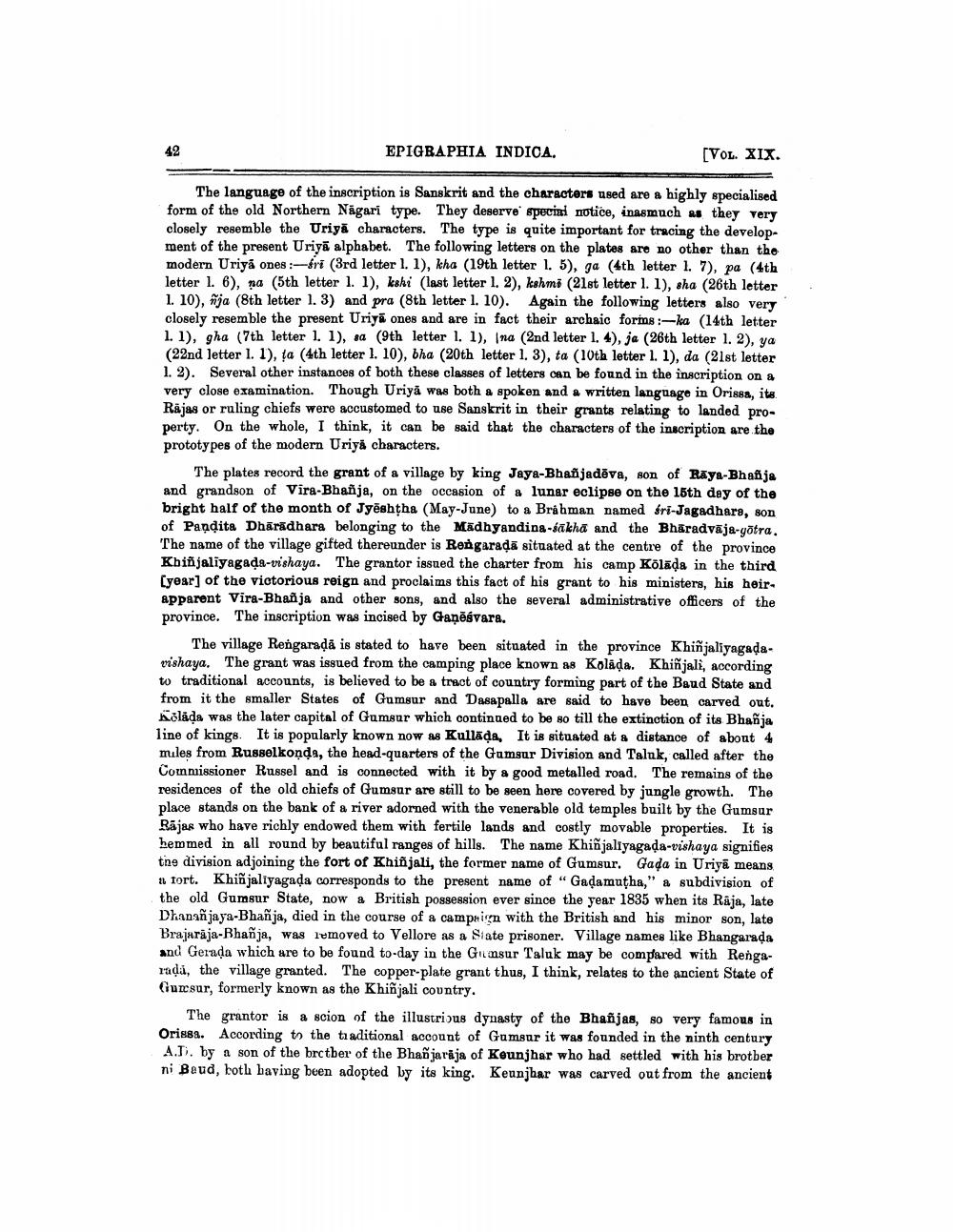________________
EPIGRAPHIA INDICA,
[VOL. XIX.
The language of the inscription is Sanskrit and the characters used are a highly specialised form of the old Northern Någari type. They deserve special notice, inasmuch as they very closely resemble the Uriga characters. The type is quite important for tracing the development of the present Uriyā alphabet. The following letters on the plates are no other than the modern Uriya ones :-fri (3rd letter l. 1), kha (19th letter 1. 5), ga (4th letter l. 7), pa (4th letter 1. 6), na (5th letter 1. 1), kshi (last letter l. 2), kshmi (21st letter 1. 1), sha (26th letter 1. 10), fija (8th letter 1.3) and pra (8th letter l. 10). Again the following letters also very closely resemble the present Uriya ones and are in fact their archaic forms:---ka (14th letter 1.1), gha (7th letter 1. 1), sa (9th letter l. 1), Ina (2nd letter 1. 4), ja (26th letter 1. 2), ya (22nd letter 1. 1), ța (4th letter l. 10), bha (20th letter 1. 3), ta (10th letter l. 1), da (21st letter 1.2). Several other instances of both these classes of letters can be found in the inscription on a very close examination. Though Uriya was both a spoken and a written language in Orissa, its Rajas or ruling chiefs were accustomed to use Sanskrit in their grants relating to landed property. On the whole, I think, it can be said that the characters of the inscription are the prototypes of the modern Uriya characters.
The plates record the grant of a village by king Jaya-Bhanjadēva, son of Raya-Bhañja and grandson of Vira-Bhanja, on the occasion of a lunar eclipse on the 15th day of the bright half of the month of Jyēshtha (May-June) to a Brahman named fri-Jagadhars, son of Pandita Dhāradhara belonging to the Mädhyanding-šākha and the Bharadvāja-yötra. The name of the village gifted thereunder is Rengaradā situated at the centre of the province Khiñjaliyagada-vishaya. The grantor issued the charter from his camp Kölāda in the third [year] of the victorious reign and proclaims this fact of his grant to his ministers, his heir. apparent Vira-Bhanja and other sons, and also the several administrative officers of the province. The inscription was incised by Gaņēsvara.
The village Rengarada is stated to have been situated in the province Khiñjaliyagadavishaya. The grant was issued from the camping place known as Koláda. Khiñjali, according to traditional accounts, is believed to be a tract of country forming part of the Baud State and from it the smaller States of Gumsur and Dasapalla are said to have been carved out. Koláda was the later capital of Gumeur which continued to be so till the extinction of its Bhañja line of kings. It is popularly known now as Kullada. It is situated at a distance of about 4 miles from Russelkonda, the head-quarters of the Gumsur Division and Taluk, called after the Commissioner Russel and is connected with it by a good metalled road. The remains of the residences of the old chiefs of Gumsur are still to be seen here covered by jungle growth. The place stands on the bank of a river adorned with the venerable old temples built by the Gumsur Rājas who have richly endowed them with fertile lands and costly movable properties. It is hemmed in all round by beautiful ranges of hills. The name Khinjaliyagada-vishaya signifies tne division adjoining the fort of Khiñjali, the former name of Gumsur. Gada in Uriyā means at fort. Khiñjaliyagada corresponds to the present name of " Gadamutha," a subdivision of the old Gumsur State, now a British possession ever since the year 1835 when its Rāja, late Dhananjaya-Bhañja, died in the course of a campaign with the British and his minor son, late Brajarāja-Bhañja, was removed to Vellore as a State prisoner. Village names like Bhangarada and Gerada which are to be found to-day in the Gransur Taluk may be compared with Rengaradi, the village granted. The copper-plate grant thus, I think, relates to the ancient State of Cursur, formerly known as the Khiñjali country.
The grantor is a scion of the illustrious dynasty of the Bhañjas, so very famous in Orissa. According to the traditional account of Gameur it was founded in the ninth century AJ). by a son of the brctber of the Bhañjarāja of Keunjhar who had settled with his brotber ni Beud, both having been adopted by its king. Keunjhar was carved out from the ancient




